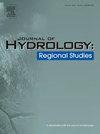Mechanisms of climate-induced lake dynamics in the Source Region of Three Rivers, Tibetan Plateau
IF 4.7
2区 地球科学
Q1 WATER RESOURCES
引用次数: 0
Abstract
Study region
The Source Region of the Three Rivers (SRTR), Tibetan Plateau, China.
Study focus
Lake variation studies in the SRTR have primarily focused on a few large lakes, with limited understanding of the long-term trends, stages, and main driving mechanisms of change in lakes larger than 1 km², especially the role of groundwater. This study proposes an attributing framework based on trend tests and water balance to investigate the changes in SRTR lakes with areas over 1 km² from 1990 to 2019. Nearly all potential drivers of lake dynamics, including groundwater, precipitation, evapotranspiration, glaciers, permafrost, and geological structure, are incorporated into the analysis.
New hydrological insights for the region
Results indicate an upward trend in the number of lakes (approximately 29 %), area (around 17 %), and volume (growing at an estimated 0.23 Gt/yr). Trend tests and water balance methods revealed that changes in groundwater significantly impacted 47 lakes (including 18 endorheic and 7 exorheic basins). Incorporating precipitation, evapotranspiration, and other factors, we further classified these changes into eight expansion patterns (involving 198 lakes) and four shrinkage patterns (involving 4 lakes), highlighting the diverse response mechanisms of lakes. Additionally, a three-phase evolutionary trend in the spatiotemporal dynamics of lakes was identified, providing a scientific basis for precise water resource regulation and lake ecosystem protection under different future scenarios in the SRTR.
求助全文
约1分钟内获得全文
求助全文
来源期刊

Journal of Hydrology-Regional Studies
Earth and Planetary Sciences-Earth and Planetary Sciences (miscellaneous)
CiteScore
6.70
自引率
8.50%
发文量
284
审稿时长
60 days
期刊介绍:
Journal of Hydrology: Regional Studies publishes original research papers enhancing the science of hydrology and aiming at region-specific problems, past and future conditions, analysis, review and solutions. The journal particularly welcomes research papers that deliver new insights into region-specific hydrological processes and responses to changing conditions, as well as contributions that incorporate interdisciplinarity and translational science.
 求助内容:
求助内容: 应助结果提醒方式:
应助结果提醒方式:


